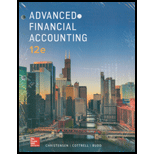
a
Introduction: When an affiliate of the issuer later acquires bonds from an unrelated party, the bonds are retired at the time of purchase. The bonds are not held outside the consolidated entity once another company within the consolidated entity purchases them, it must be treated as repurchase by the debtor. The acquisition of an affiliate’s bonds by another company within affiliated entities is referred to as constructive retirement. Although bonds are not actually retired.
When constructive retirement occurs the consolidated income statement reports gain or loss based on the difference between carrying value and purchase price paid by the affiliate to acquire it. And it is not reported in the consolidated
The worksheet consolidation entries as of December 31, 20X4, to complete consolidated balance sheet worksheet assuming S earned $74,476 and paid $10,000 in dividends during the year.
b
Introduction: When an affiliate of the issuer later acquires bonds from an unrelated party, the bonds are retired at the time of purchase. The bonds are not held outside the consolidated entity once another company within the consolidated entity purchases them, it must be treated as repurchase by the debtor. The acquisition of an affiliate’s bonds by another company within affiliated entities is referred to as constructive retirement. Although bonds are not actually retired.
When constructive retirement occurs the consolidated income statement reports gain or loss based on the difference between carrying value and purchase price paid by the affiliate to acquire it. And it is not reported in the consolidated balance sheet either as bond payable or as an investment because the bonds are no longer outstanding.
The preparation of consolidation worksheet for 20X4
c
Introduction: When an affiliate of the issuer later acquires bonds from an unrelated party, the bonds are retired at the time of purchase. The bonds are not held outside the consolidated entity once another company within the consolidated entity purchases them, it must be treated as repurchase by the debtor. The acquisition of an affiliate’s bonds by another company within affiliated entities is referred to as constructive retirement. Although bonds are not actually retired.
When constructive retirement occurs the consolidated income statement reports gain or loss based on the difference between carrying value and purchase price paid by the affiliate to acquire it. And it is not reported in the consolidated balance sheet either as bond payable or as an investment because the bonds are no longer outstanding.
The preparation of consolidation worksheet for 20X4
Want to see the full answer?
Check out a sample textbook solution
Chapter 8 Solutions
ADVANCED FINANCIAL ACCT.(LL) >CUSTOM<
- Olivia Production calculates its overhead budget based on budgeted machine-hours. The production schedule indicates that 12,400 machine-hours will be required in November. The variable overhead rate is $8.50 per machine-hour. The company's budgeted fixed manufacturing overhead is $186,000 per month, which includes depreciation of $43,000. All other fixed manufacturing overhead costs represent current cash flows. The company recomputes its predetermined overhead rate every month. What should be Olivia Production's predetermined overhead rate for November? A. $23.50 B. $18.90 C. $21.26 D. $16.00arrow_forwardI want the correct answer with accountingarrow_forwardWhat is the value of ending inventory assuming the use of direct costing ?arrow_forward
- general accountingarrow_forwardSkynet Corporation estimates that its employees will utilize 225,000machine hours during the coming year. Total overhead costs are estimated to be $5,625,000 and direct labor hours are estimated to be 150,000. Actual machinehours are 210,000. Actual labor hours are 140,000. If Skynet Corporation allocates overhead based on machine hours, what is the predeterminedmanufacturing overhead rate?arrow_forwardPlease explain the solution to this general accounting problem with accurate explanations.arrow_forward

 AccountingAccountingISBN:9781337272094Author:WARREN, Carl S., Reeve, James M., Duchac, Jonathan E.Publisher:Cengage Learning,
AccountingAccountingISBN:9781337272094Author:WARREN, Carl S., Reeve, James M., Duchac, Jonathan E.Publisher:Cengage Learning, Accounting Information SystemsAccountingISBN:9781337619202Author:Hall, James A.Publisher:Cengage Learning,
Accounting Information SystemsAccountingISBN:9781337619202Author:Hall, James A.Publisher:Cengage Learning, Horngren's Cost Accounting: A Managerial Emphasis...AccountingISBN:9780134475585Author:Srikant M. Datar, Madhav V. RajanPublisher:PEARSON
Horngren's Cost Accounting: A Managerial Emphasis...AccountingISBN:9780134475585Author:Srikant M. Datar, Madhav V. RajanPublisher:PEARSON Intermediate AccountingAccountingISBN:9781259722660Author:J. David Spiceland, Mark W. Nelson, Wayne M ThomasPublisher:McGraw-Hill Education
Intermediate AccountingAccountingISBN:9781259722660Author:J. David Spiceland, Mark W. Nelson, Wayne M ThomasPublisher:McGraw-Hill Education Financial and Managerial AccountingAccountingISBN:9781259726705Author:John J Wild, Ken W. Shaw, Barbara Chiappetta Fundamental Accounting PrinciplesPublisher:McGraw-Hill Education
Financial and Managerial AccountingAccountingISBN:9781259726705Author:John J Wild, Ken W. Shaw, Barbara Chiappetta Fundamental Accounting PrinciplesPublisher:McGraw-Hill Education





